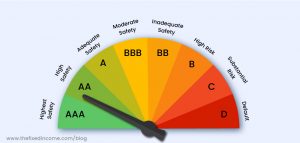Introduction
Over the last two decades, credit rating has gained significant importance among investors and within the Indian financial market. Essentially, it evaluates an individual or entity’s capacity and reliability when seeking to borrow money performed by authorized Credit Rating Agencies (CRAs). It measures their ability to repay loans, considering their willingness and capability to meet debt obligations promptly.
Credit rating agencies must possess expertise to accurately assess credit quality. The ratings they provide offer a concise overview for economic decision-makers.
The concept of credit rating originated in the USA in 1909 with Moody’s assessments of corporate and railroad bonds. Since then, this practice has been adopted by numerous countries globally.
In India, the journey of credit rating began in 1988 by establishing Credit Rating and Investor Services of India Ltd (CRISIL).
What is a Credit Rating?
Credit ratings assess the creditworthiness of individuals, businesses, or governments to repay debt. They’re graded from AAA (highly safe) to D (default) which credit rating agencies assign. These ratings play an important role for lenders, investors, and other stakeholders to gauge credit risk associated with a specific borrower or investment. High ratings mean a lower risk of default risk, while low ones imply higher risk. Credit rating agencies (CRAs) are specialized organizations that assess credit risk by collecting, analyzing, and assigning ratings based on borrowers’ credit histories.
What is a Credit Rating Agency?
A credit rating agency is an organization that evaluates the borrowing capability of different entities, by using a range of metrics and factors, while also forecasting the likelihood of potential defaults. CRAs utilize a rating scale to evaluate creditworthiness, typically ranging from AAA (representing the lowest risk of default) to D (indicating default). Further, the rating agencies also give a +/- sign across all ratings indicating the comparative standing within the category. However, the specific scales employed may vary across agencies. It helps investors and lenders gauge the risk associated with lending significant amounts to these organizations.
Factors that affect Credit Ratings
Credit ratings are crucial within the financial sphere as they provide investors and lenders with an assessment of a borrower’s creditworthiness. Credit rating agencies (CRAs) assign credit ratings to borrowers based on two categories: quantitative and qualitative factors.
Quantitative Factors
Financial performance: The credit ratings of an entity are significantly influenced by its financial performance, which includes metrics such as cash flow, profitability, and the rate of sales growth. These measures evaluate an organization’s capacity to make money, pay back debts, and control risk.
Debt-to-equity Ratio: The debt-to-equity ratio measures the proportion of debt to equity held by an entity. A high debt-to-equity ratio indicates that the company has a high amount of debt compared to its equity, which raises the default risk. Conversely, a company with a low debt-to-equity ratio has less than equity, reducing the likelihood of default.
Market Conditions: Changes in market conditions such as fluctuating interest rates, inflation, and economic growth can impact credit ratings. In an economy with rising interest rates, it becomes harder for entities to pay off their debts, thereby hurting their credit ratings.
Industry Trends: Changes in market trends also influence credit ratings such as a drop in the customer demand for a company’s products or services can decrease revenue growth and profitability, which may lead to a downgrade in the credit rating.
Qualitative Factors
Management Team: CRAs evaluate the proficiency and expertise of a borrower’s management team.
Industry Risk: CRAs also take into account the risk profile of the industry in which a borrower is operating. Industries that are more cyclical or subject to intense competition may be assigned lower ratings.
Country Risk: CRAs also analyze the borrower’s country in which it is domiciled. Countries experiencing greater political or economic instability might have lower ratings for borrowers.
Apart from the above factors, Credit rating Agencies (CRAs) take into account aspects like the borrower’s competitive standing, market share, and performance in environmental, social, and governance (ESG) areas, and many others. The points mentioned above are illustrative and not an exhaustive one.
It’s noteworthy that credit ratings don’t guarantee performance or repayment. Nevertheless, they merely serve as a valuable tool for lenders, borrowers, investors, and regulators in assessing the creditworthiness of borrowers and making well-informed investment choices.
Credit Rating Agencies in India
In India, seven credit rating agencies (CRAs) are registered with the Securities and Exchange Board of India (SEBI). These are:
-
CRISIL (Credit Rating Information Services of India Limited)
-
ICRA (Investment Information and Credit Rating Agency of India)
-
CARE (Credit Analysis and Research Limited)
-
India Ratings and Research Private Limited
-
Acuite Ratings and Research Limited
-
Infomerics Valuation and Rating
-
Brickwork Ratings India Pvt. Ltd.


Types of Ratings
Credit ratings classify bonds based on their quality and likelihood of default, using a grading system from AAA for the most secure to D for defaulted bonds.
- AAA & AA: These signify top-tier, low-risk investment-grade bonds.
- A & BBB: This is the investment-grade rating and bonds in this category carry a moderate risk of default.
- BB & B: These are non-investment grade or junk bonds with higher default risks.
- C & D: They are defaulted bonds, signifying the highest risk.
Along with these grades, agencies offer an outlook on the rating- positive, negative, or stable. A positive outlook signifies a potential rating upgrade in the future, while a negative outlook signifies that the rating may be downgraded.

Types of Credit Ratings
Credit rating agencies use alphabetical symbols as their rating scale to assess the default risk linked to a bond. Bonds are divided into two categories based on these ratings- investment grade- lower risk bond and non-investment grade- higher risk bond but have the potential for greater returns.
Investment grade: Bonds with an investment-grade credit rating indicate that a company has made sound investment decisions and is well-positioned to repay debts. Entities in this category can easily access loans at favorable, lower interest rates. It signifies a minimal risk of default linked to these bonds. Consequently, these bonds present an attractive investment opportunity for investors. The ratings for these bonds start from AAA to BBB-.
Speculative Grade: Non-investment grade type of bond credit ratings carry a high risk of default linked with the bonds. Companies in this category have undertaken riskier business investments, indicating that the issuer might struggle to repay both the principal amount and interest on schedule. Consequently, these entities can secure loans but typically at higher interest rates. These companies typically hold lower credit ratings like BB, B, or C.
However, the rating does not remain stagnant and changes with the improvement in the financials, profitability, and other relevant factors.
Let’s understand what a Rating Upgrade means
An upgrade refers to a favorable adjustment in a security’s rating, typically prompted by steady improvements in the issuing entity’s fundamentals and financial performance. Credit rating agencies issue these upgrades for corporate issuers of debt securities. Upgrades occur when a bond’s rating rises, while downgrades happen when it falls.
An upgrade in a bond’s rating impacts the following:
- When a credit rating agency upgrades an issuer’s credit rating, it has a positive impact on all existing bonds and other fixed-income instruments of the issuer.
- It has a direct impact on fixed-income yields, and therefore directly affects bond prices. An upgrade in a bond’s rating typically leads to an increase in its price as investors become more willing to pay more for the bond, even if it means accepting a lower yield.
- An upgrade implies the borrower’s risk profile has improved, so the interest demanded on their debt decreases, thereby increasing its price.


Bond ratings shift due to various factors, including default risk, shifts in an issuer’s financial position, their profit prospects, broader economic conditions, and more.
Factors contributing to an upgrade include:
- Strengthening of the issuer’s financial standing through increased cash reserves and reduced debt.
- Positive shifts in business conditions such as improved profit margins, increased earnings, and a robust economy.
- Evolving industry trends like increased demand for products/services or regulatory changes benefiting the company.
- Issuer-initiated proactive regulatory measures designed to navigate challenging economic situations effectively
- Others.
Importance of Credit rating
Credit ratings are very crucial for borrowers as they serve as a gauge of their financial reliability. The significance of credit ratings is much deeper and influences various aspects of finance and investment decisions.
Risk evaluation: Credit ratings serve as a tool for evaluating risk, providing an independent evaluation of a borrower’s likelihood of defaulting on financial obligations. This evaluation is equally important for lenders, investors, and anyone considering entering into a financial relationship with the borrower.
Interest Rates: Credit ratings influence the interest rates that borrowers secure: higher credit ratings signify lower risk, therefore, borrowers can access loans and credit at lower interest rates. This reduced borrowing cost can lead to substantial savings over time.
Investment decisions: Credit ratings play a pivotal role for investors in the decision-making process. A high rating implies lower default risk, making investments more attractive. Conversely, a low rating indicates a warning sign that an investment carries a higher level of risk.
Capital Market Access: Credit ratings affect entities access to capital markets. Higher-rated entities can issue bonds and other securities more easily and at a lower cost compared to lower-rated counterparts.
Conclusion
Summing up, understanding the dynamics of credit rating is essential in navigating the financial landscape. Credit ratings serve multiple stakeholders including lenders, borrowers, investors, and regulators to foster financial stability, transparency, and efficiency. Having a proper understanding of the elements influencing credit ratings. However, it is important to understand that credit ratings serve as a medium to filter investment options but are not final and binding. There are instances where AAA-rated bonds have also defaulted in their interest and principal repayment. It is always advisable to carry out your research before making an investment decision and not rely fully on the credit ratings of the company.
Disclaimer: Investments in debt securities/ municipal debt securities/securitized debt instruments are subject to risks including delay and/ or default in payment. Read all the offer-related documents carefully.
Frequently Asked Questions
Q1. What is a credit rating?
Ans. A credit rating involves both qualitative and quantitative assessment of the likelihood of default on interest and principal payments for a debt instrument. It doesn’t recommend buying, selling, or holding a debt instrument. Instead, it provides additional information for investors which can be helpful before making investment decisions.
Q2. How is a rating denoted?
Ans. Rating is denoted by a simple alpha-numeric symbol from AAA for the most secure to D for defaulted bonds.
Q3. What do the “+” and “-” symbols denote in a rating?
Ans. The plus and minus symbols used in rating categories denote finer distinctions without any negative implications. Ratings in a higher rating category like ‘AA-‘ indicate stronger standing compared to those in lower categories like ‘A+’.
Q4. Who regulates rating agencies?
Ans. Credit rating agencies are regulated by the Securities and Exchanges Board of India (SEBI). The SEBI (Credit Rating Agencies) Regulations, 1999 outline the criteria for registration, monitoring of ratings, avoidance of conflict of interest, proper rating processes, and inspections of these agencies by SEBI, among other provisions.
Q5. What is the validity period of a credit rating?
Ans. A rating remains valid until it is withdrawn which is usually when the rated debt obligation is completely repaid.






















